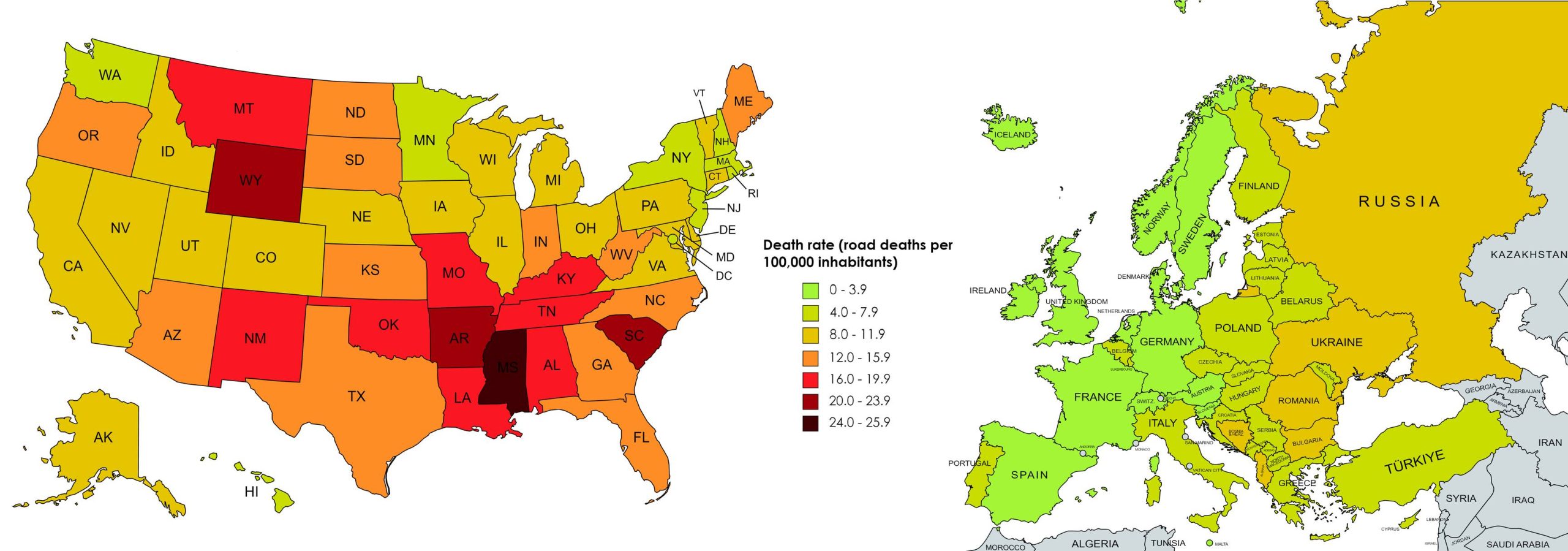Map by Reddit user flyingcatwithhorns
If you’ve ever driven through Europe and then returned to American roads, you might have noticed something profound: the entire driving culture feels different. The data backs up this intuition.
Road traffic deaths per 100,000 inhabitants tell a stark story. Most of Europe glows green and yellow on safety maps, while swaths of the American South and mountain states blaze red and dark brown.
What the Numbers Reveal
European countries consistently maintain road death rates below 8 per 100,000 people, with many nations like Norway, Sweden, and the United Kingdom achieving rates below 4.
Meanwhile, American states like Mississippi, Alabama, and Wyoming clock in at over 20 deaths per 100,000 residents. That’s a fivefold difference in some cases.
Why Europe Does Better
The difference isn’t about driver skill or intelligence. It’s about infrastructure and policy choices that add up over decades.
European cities were built for people first, cars second. Narrow streets naturally slow traffic. Extensive public transit means fewer people need to drive long distances. Protected bike lanes and pedestrian zones create separation between vulnerable road users and vehicles.
Speed limits in Europe are enforced with automated cameras that actually issue tickets. In Germany, even the famous autobahn sections without speed limits are engineered with exceptional sight lines and maintenance standards. Driver education is more rigorous and expensive, creating a higher barrier to licensure.
The American Challenge
American infrastructure tells a different story. Our cities sprawl outward, making cars a necessity rather than a choice. Rural highways stretch for hundreds of miles with minimal safety features. Many states have higher speed limits and looser enforcement.
The deadliest American states share common characteristics: rural populations spread across vast distances, limited public transportation, older vehicle fleets, and lower rates of seatbelt use. Economic factors play a role, too. Poorer states often have older roads with fewer safety upgrades.
Hope on the Horizon
Some American cities are learning from European examples. Protected bike lanes are appearing in urban centers. Traffic calming measures like roundabouts and speed bumps are becoming more common. Vision Zero initiatives aim to eliminate traffic deaths entirely through systemic changes.
The gap between American and European road safety isn’t inevitable. It’s the result of choices about urban planning, infrastructure investment, and enforcement priorities. Every green zone on that European map represents policies and designs that saved lives.
Understanding this difference matters because it shows us that safer roads are possible. We’re not destined to accept current death rates as normal. The European example proves that systematic changes to how we design roads, enforce laws, and plan communities can cut traffic deaths dramatically.
The question isn’t whether we can make our roads safer. The question is whether we’ll make the choices necessary to do so.
Help us out by sharing this map:
